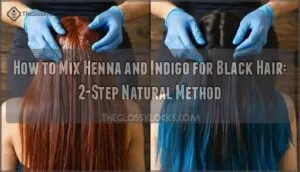This site is supported by our readers. We may earn a commission, at no cost to you, if you purchase through links.
 Here’s the thing about henna and indigo for black hair—you can’t just throw them together in one bowl. It’s actually a two-step dance.
Here’s the thing about henna and indigo for black hair—you can’t just throw them together in one bowl. It’s actually a two-step dance.
First, you coat your hair with henna to get that orange-red base going. Then you hit it with indigo right after, which transforms that red into deep black.
Get your henna powder mixed with warm water, then give it a few hours to do its thing and release that color.
Once you’ve applied it and rinsed everything out, don’t wait around—grab some fresh indigo, mix it with lukewarm water, and get it all over that newly hennaed hair while it’s still primed.
That layering approach beats any single treatment hands down when it comes to stubborn grays.
It’s all about how these ancient dyes work together to lock in that rich, lasting color.
Table Of Contents
- Key Takeaways
- What is The Two-Step Henna and Indigo Process?
- How to Prepare Henna for Black Hair
- How to Mix and Apply Indigo Dye
- Step-by-Step Application for Best Black Results
- Maintaining and Enhancing Black Hair Color
- Frequently Asked Questions (FAQs)
- Are henna and indigo safe to use?
- Will henna and indigo work on dark hair?
- How long does henna and indigo last?
- What is the difference between henna and indigo powders?
- Is it necessary to shampoo hair before applying henna and indigo?
- How often should I reapply henna and indigo?
- Can I use henna indigo on chemically treated hair?
- Whats the shelf life of mixed henna paste?
- Does henna indigo work on blonde or light hair?
- Can I add essential oils to henna mixture?
- Conclusion
Key Takeaways
- You’ll need to use a two-step process—apply henna first, then indigo separately, never mix them together for the best black results. Let your henna paste sit for 6-12 hours to release dye properly, but mix and apply indigo immediately since it loses potency fast. You’ll get better gray coverage with this method than with single-step applications, especially if you’re dealing with stubborn, resistant hair. * Wait 48 hours before shampooing after your final indigo application to let the color fully set and deepen into a rich black.
What is The Two-Step Henna and Indigo Process?
The two-step henna and indigo process applies henna first, then indigo to create rich black hair color naturally.
You’ll get better coverage and deeper color than mixing both powders together, especially if you’re working with stubborn grays that laugh at regular hair dye.
How Henna and Indigo Work Together
Mix henna and indigo together, and you get nature’s chemistry at work. Henna’s tannins lay down the base layer, then indigo molecules lock onto that foundation through a process called dye layering.
When henna and indigo team up, they create a chemical bond that delivers those deep black tones you’re after.
The tannins don’t just color your hair—they actually feed the good bacteria on your scalp, giving you gorgeous results that are kind to your head.
Why The Two-Step Method Achieves Black Hair
Getting black hair with this two-step process is pretty clever—think of it like mixing paint colors. The henna goes on first, leaving behind orange-red pigments in your hair.
When you add indigo next, something cool happens. Those blue indigo tones grab onto the henna’s reds, and boom—you get that rich black color from the chemical reaction.
This color layering technique ensures complete grey coverage where single applications often fail.
Suitability for Grey and Resistant Hair
This two-step method works exceptionally well for stubborn grey hair that commonly resists regular dyes. You’ll achieve up to 100% grey coverage when dealing with resistant hair types, unlike single-step applications that only work on hair with less than 10% grey. The henna and indigo combination penetrates coarse, difficult-to-color strands more effectively than conventional products. This process helps to maintain hair health while achieving the desired color.
Here’s why it’s perfect for challenging hair:
- Grey Coverage Issues – Two applications assure complete saturation where other methods fail
- Resistant Hair Types – Coarse, wiry greys respond better to this natural process
- Pre-Treatment Options – Adding salt to indigo powder improves color uptake by 15%
- Henna Indigo Ratio – Sequential application allows greatest dye penetration
- Application Techniques – Heat during henna processing reduces time by 50% on stubborn strands
How to Prepare Henna for Black Hair
Getting your henna paste right sets the foundation for rich, even black color that’ll make your friends wonder if you hit the salon.
You’ll need to mix pure henna powder with warm water, lemon juice, and let it sit for several hours so the dye can fully activate and work its magic on your hair.
Choosing Pure Henna Powder
Pure organic henna is your foundation for rich black hair results. Look for packages labeled "100% Lawsonia inermis" with USDA organic certification. Quality henna powder appears deep green with a fine texture—avoid anything containing PPD or synthetic additives. To assure safety, it’s best to use henna that’s batch tested for metals.
| Quality Indicator | What to Look For |
|---|---|
| Color | Deep green powder |
| Texture | Fine, non-gritty consistency |
| Certification | USDA organic or ECOCERT |
| Ingredients | 100% Lawsonia inermis only |
| Origin | Rajasthan, Sudan, or Morocco |
Mixing Henna Paste (Water, Lemon, Tea)
You know how pancake batter should pour smoothly but not be watery? That’s exactly what you’re going for with henna paste.
Start by mixing your henna powder with warm water, then squeeze in some fresh lemon juice—it actually helps the dye work better.
Brewed black tea works as a liquid alternative too. Use non-metal mixing utensils to avoid reactions, and aim for a paste temperature that’s comfortably warm to touch when preparing hair color pastes.
Dye Release Timing and Tips
Once you’ve got your henna paste mixed, here comes the hardest part—waiting. Give it 6-12 hours to rest so the dye can release properly. You’ll know it’s happening when the surface starts looking darker.
This waiting period is where the real magic happens. Want to speed things up? Pop it somewhere warm—around 100°F or hotter works great. Heat is your friend here, while cold weather will slow everything down.
Watch for these Visual Dye Cues that signal your henna powder is ready:
- The paste surface darkens from green to rust-brown
- A slightly metallic scent develops
- The mixture thickens naturally over time
- Small bubbles may appear on the surface
- The paste feels smoother when stirred
Remember, dye release time varies by brand and conditions. Unlike henna powder that needs this wait, indigo powder requires Indigo Immediate Use after mixing—no waiting required when preparing henna and indigo together.
Preparing Hair for Application
Once your henna’s ready to go, prep becomes everything. Start with clean, dry hair—wash with sulfate-free shampoo to remove product buildup. Skip pre-wash oils and protein treatments this time. Check your scalp condition first, then do a skin patch test for allergic reactions. Test a hair strand too.
Here’s your prep checklist:
Hair Prep Scalp Care
Use gentle detangling methods before starting.
How to Mix and Apply Indigo Dye
Now you’ll mix indigo powder with lukewarm water to create a smooth paste that works immediately after henna treatment.
You’ll need to apply this indigo mixture right away since it loses its potency quickly, covering every strand of your freshly rinsed, henna-colored hair for even black results.
Selecting Quality Indigo Powder
After you’ve got your henna ready, it’s time to find good indigo powder—this is what gives you that rich black color.
Here’s the thing: indigo quality varies wildly, and it makes all the difference in your final look.
Here’s what to look for:
- 100% Indigofera tinctoria – Skip anything with synthetic additives or adulterants that could damage your hair
- Fine particle size – Well-ground indigo powder mixes better and penetrates hair more evenly
- Fresh, dated packaging – Older indigo loses dye content, affecting color intensity and coverage
Premium plantbased hair dyes maintain indigo purity through careful processing, which means you’ll get consistent black results without the guesswork that comes with low-quality alternatives.
Mixing Indigo With Water and Additives
Mix your indigo powder with lukewarm water to create a smooth, yogurt-like consistency. The water temperature matters—too hot kills the dye, too cold won’t activate it properly.
Skip additives like lemon or salt here; they’ll interfere with indigo’s alkaline nature. Work quickly since paste oxidation begins immediately, reducing effectiveness for your black hair transformation.
Timing and Immediate Application
Once your indigo powder paste reaches the right consistency, time becomes your biggest ally. Unlike henna paste, which benefits from sitting, indigo powder paste demands immediate use for peak color payoff.
The paste loses potency quickly, so apply it within 15–20 minutes of mixing. Fresh indigo paste grabs onto your henna-colored hair better, creating that deep black you’re after. Don’t let it sit around—your hair is waiting for that instant application urgency to work its magic.
Covering All Henna-Colored Hair
Every strand needs thorough indigo coverage to achieve rich black hair color. Work systematically through each section, making certain complete coverage tips include overlapping applications where henna and indigo meet.
Focus extra attention on resistant gray hair areas and roots for even application. This prevents patchiness and delivers uniform results across your entire head.
Step-by-Step Application for Best Black Results
Now you’ll apply both henna and indigo using proper techniques that guarantee even coverage and deep black results. You’ll work section by section, timing each step carefully to get the rich, natural black color you want without damaging your hair.
Sectioning and Applying Henna Paste
Start at your crown and work methodically through each hair section. Your henna paste should feel like thick yogurt—smooth but not dripping.
Use a coloring brush for precision or gloved hands for speed. Focus on even coverage techniques, saturating each strand from root to tip.
Don’t rush this step; thorough application prevents patchy results later.
Rinsing and Preparing for Indigo
After your henna has processed completely, it’s time for the henna rinse-out phase. Rinse thoroughly with cool water until it runs clear, removing all henna residue while being gentle on your scalp. Pat hair dry with a towel—avoid aggressive rubbing that could cause scalp sensitivity. Your hair should feel clean but not stripped before preparing indigo hair dye application.
- Rinse henna with cool water only (no shampoo) to preserve the color base
- Gently squeeze out excess water without rough towel-drying that damages hair
- Check for any remaining henna particles around the hairline and ears
- Allow hair to air dry slightly so it’s damp but not dripping wet
- Inspect your scalp for any irritation before proceeding with indigo
Applying Indigo Over Hennaed Hair
Now comes the game-changing moment—applying your freshly mixed indigo paste over your henna-colored hair. Work quickly, as indigo application timing matters most in the first 15 minutes after mixing. The paste consistency is crucial; aim for yogurt thickness to prevent dripping. You’ll need complete coverage on every strand that touched henna earlier. Temperature considerations play a role—lukewarm paste works best.
This two-step process transforms your red-orange henna base into rich black hair through indigo’s blue pigments.
Processing Time and Rinsing Techniques
Let indigo sit for 1-2 hours for deep black results. This indigo processing duration allows greatest color deepening time. Rinse with cool water—hot temperatures fade color fast.
Skip shampoo for 48 hours so the dye release continues working. If you see red tones after rinsing, don’t panic. Multiple indigo applications help achieve true black hair color.
Recommended Tools and Protective Gear
Having the right gear makes all the difference when applying henna and indigo. You’ll need mixing bowls for each paste, application brushes or gloved hands for even coverage, and a processing cap to retain heat.
Protect your clothing with old shirts or capes, and use pillow protection during processing time. Quality latex or nitrile gloves prevent staining while sectioning hair for precise coloring brush work.
Maintaining and Enhancing Black Hair Color
You’ve successfully created rich black hair color, but your work isn’t finished yet.
The next 48 hours are important for locking in that deep shade and making sure your natural dye job lasts as long as possible.
First Wash and Shampoo Recommendations
{{
Color Deepening and Longevity Tips
Something magical happens when you build layers of color over time. For deeper black results, repeat full indigo reapplication every 6-8 weeks—this progressively intensifies your shade.
Between sessions, try root touch-ups with indigo-only treatments to maintain blended coverage.
Oil treatments with coconut or argan help lock in pigments while protecting against sun damage. Always use sulfate-free products and consider color glosses for enhanced hair color retention.
Troubleshooting Common Issues (Red Tones, Uneven Color)
Even with perfect timing, you might face stubborn red tones or patchy results. Don’t panic—these issues have straightforward fixes that’ll get your hair back on track.
Common Red Tone Correction and Uneven Color Causes:
- Persistent red tones after indigo application – Your henna mix contained over 60% henna, or you applied indigo for less than 45 minutes
- Patchy, uneven color distribution – Improper sectioning during application or using oxidized indigo paste mixed over 10 minutes ago
- Incomplete darkening to true black – Using simultaneous henna-indigo mix instead of proper two-step process, or applying to unwashed, product-laden hair
For Application Mistakes requiring Indigo Reapplication, wait 24-48 hours before repeating the indigo step. Root Touch-Ups need fresh indigo paste applied only to new growth areas.
Aftercare for Hair Health and Shine
Your hair care routine after henna and indigo treatment makes all the difference. Focus on moisture retention with deep conditioning masks weekly.
Gentle cleansing with sulfate-free shampoos protects your color from fading while maintaining scalp health.
Natural shine boosters like coconut oil or argan oil boost your black hair’s luster. Proper hair treatment preserves both color and hair health for weeks.
Frequently Asked Questions (FAQs)
Are henna and indigo safe to use?
Nature’s gentle touch makes these plant-based beauties safer than harsh chemicals.
You’ll appreciate that pure henna and indigo won’t damage your hair like synthetic dyes do, though patch testing helps avoid rare sensitivities.
Will henna and indigo work on dark hair?
Yes, henna and indigo will work on dark hair, but you won’t see dramatic lightening. They’ll add rich tones and conditioning benefits while deepening your natural color beautifully.
How long does henna and indigo last?
Henna and indigo generally last 4-6 weeks before you’ll need a touch-up.
Henna hair dye will begin to fade between 4 to 6 weeks after the initial application, though with repeated applications, you’ll get longer-lasting, more vibrant color.
What is the difference between henna and indigo powders?
These two powders work completely differently: henna gives you those warm reddish-brown shades from Lawsonia inermis leaves, while indigo pulls deep blue-black color from Indigofera tinctoria.
You’ll find henna conditions hair naturally, whereas indigo primarily provides darker coloring when layered over henna-treated strands.
Is it necessary to shampoo hair before applying henna and indigo?
Clean, dry hair works best for henna and indigo application. Skip shampooing beforehand—natural oils actually help the paste stick better and protect your scalp from potential irritation during the coloring process.
How often should I reapply henna and indigo?
Good things come to those who wait—reapply henna and indigo every 4-6 weeks to maintain vibrant black color.
Your hair’s growth rate and desired intensity determine timing, but monthly touch-ups keep roots covered perfectly.
Can I use henna indigo on chemically treated hair?
Yes, you can use henna and indigo on chemically treated hair! Pure, quality henna works safely over dyed or bleached hair – just wait 6-8 weeks after recent chemical treatments.
Whats the shelf life of mixed henna paste?
Mixed henna paste lasts about 24 hours in the fridge, but you’ll get the best color punch if you use it within 6-12 hours of mixing for peak dye release.
Does henna indigo work on blonde or light hair?
Hit the nail on the head – henna and indigo absolutely work on blonde and light hair! Indigo after henna on blonde hair creates brown to black color, but you’ll get stunning results with proper application.
Can I add essential oils to henna mixture?
You can safely add essential oils to your henna mixture! They prevent dryness, add pleasant scents, and help the dye release better.
Try eucalyptus, tea tree, or lavender for best results.
Conclusion
Mastering how to mix henna and indigo for black hair transforms your approach to natural coloring forever. You’ve discovered that patience with the two-step process creates stunning results that chemical dyes can’t match.
Mastering the two-step henna and indigo process transforms your natural coloring approach, creating stunning black results that chemical dyes simply can’t match
Your hair gains rich black color while staying healthy and strong. Remember, henna first, then indigo—never together. This ancient technique covers grays beautifully and gives you control over your color journey naturally.
- https://www.minaturewellness.com/blogs/news/henna-and-indigo-powder-the-perfect-natural-hair-dye-duo
- https://renaissancehenna.com/henna-plant-natural-hair-dye/predicting-henna-hair-colour/
- https://hennasooq.com/blogs/henna-101/complete-guide-how-to-color-your-hair-with-henna-and-indigo
- https://shop.morroccomethod.com/blogs/henna/all-about-indigo
- https://www.reddit.com/r/henna/comments/ou8hqr/scientific_study_i_found_on_henna_for_hair_soo/














